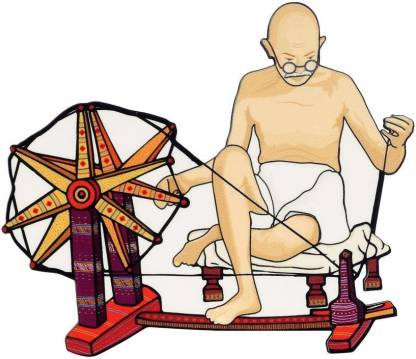How Gandhiji’s charkha keeps Indian economy backward?


Before, delving in to the matter, lets briefly discuss Japan.
The Japanese knew they were behind the Western powers when US Commodore Matthew Perry came to Japan in 1853 in large warships with armaments and technology that far outclassed those of Japan with the intent to conclude a treaty that would open up Japanese ports to trade. Commodore Perry did not attack Japan, but fired few of his Naval Canons which scared the Japanese. Japanese concluded that “if we take the initiative, we can dominate; if we do not, we will be dominated“, leading Japan to “throw open its doors to foreign technology”.
Meiji Renovation (1867) was a political event that restored practical imperial rule to Japan in 1868 under Emperor Meiji. Although there were ruling emperors before the Meiji Restoration, the events restored practical abilities and consolidated the political system under the Emperor of Japan. Before the Meiji restroration the Samurais (Japanese Military) ruled Japan.
Japanese realized that they need to Change. They invited Americans and Englishmen to Japan to teach them technology, military tactics, politics etc.
After the power of the emperor was restored, Japan adopted western technology, build industries and railways, modernized its army and navy, introduced the the parliamentary system, improved the status of women, resorted to colonialism and within 50 years became a modern, industrialized nation. In 1905 Japan defeated Russia on land and sea in the Russo-Japanese war. For the first time in modern history a tiny Asian nation defeated a bigger and powerful European power. Japan Beat West in their own game.
What did Gandhiji do?
British colonialized India. That was a setback.
Technology is worth a thousand spears. Instead of adopting technology and defeating the west in their own game, Gandhiji went a step backward. Instead of adopting machines, he adopted the hand run Charkha as a symbol of “Indianism”. Can a charkha beat a power loom in terms of volume production, market reach and standardization of products? NO.
In a way, the Charkha made India to remain away from technology. After Gandhis, the concept of Charka was carried forward. For e.g. cottage industries, handlooms were encouraged for producing clothes.
Production by machines was discouraged as part of the state policy.
IN order to protect uncompetitive cottage industries and handlooms, Indian market was insulated by imposing high tariffs barriers. The barriers helped protect the technologically backward industries, but harmed Indian exporters. Other countries imposed tariffs on Indian goods and denied Indian goods to their market. India started to get isolated from global trade. Forget China, India is now lagging behind Bangladesh in textile manufacturing.
Today, though India houses a sixth of world population, the Indian share of merchandise exports amounted to around (only)1.71 percent of the total global exports in 2019
Another example, the Indian farmers are using ancient technologies and hence are not efficient as farmers in US, EU or Australia. In order to protect them, Govt doesn’t allow food grains, milk to be imported from markets like Australia. Due to this reason, Australia also prohibits Indian manufactured goods and services in Australia. Where as in case of say Bangladesh or Vietnam, it is different. That’s why we see countries like Vietnam and Bangladesh are surpassing India in exports. Whenever, there is talk to open Indian farm sector so as get a reciprocated deal from US, EU, Australia or New Zealand, farmers start to protest.
Vietnam has made trade pacts with EU, thereby opening a big market for its finished products. But, the “protectionist” mentality has deeply penetrated Indian politics due to which neither Indian businessmen nor politicians have the confidence to go out of India and compete at a global stage.
All these problems can be attributed to “CHARKHA”. How?
Had Gandhiji been a nation builder, he should have done photo-op standing near a power loom (thereby signaling his intent to adopt technology) instead of sitting before a charkha.
DISCLAIMER: The author is solely responsible for the views expressed in this article. The author carries the responsibility for citing and/or licensing of images utilized within the text.
